General L-boat photos: Difference between revisions
Pbcjohnston (talk | contribs) No edit summary |
Pbcjohnston (talk | contribs) (Added L-3 and L-4 photo) |
||
| (11 intermediate revisions by the same user not shown) | |||
| Line 1: | Line 1: | ||
[[File:L-1 | [[File:L-Boat Header 1.jpg]] | ||
[[File:L-1-3-4.jpg|left|500px]] | |||
<div style="text-align: justify;"><span style="color:#00008B">A small photo of three L-boats at an unknown location, probably in the spring or summer of 1916. This is definitely a pre-WWI photo, as these boats do not have the installed "chariot" style bridge structures. | |||
<small>Photo in the private collection of Ric Hedman</small> | |||
[[File: | [[File:Red bar sub.jpg]] | ||
[[File:M-1 with others.jpg|left|500px]] | |||
L-2, L-4, and L-9 moored together with [[M-class|'''M-1 (Submarine No. 47)''']] at the Fore River Shipbuilding fitting out pier, April 5, 1916. All of the boats shown here are in various stages of completion. None have been commissioned. The L-boats were all of the standard Electric Boat single hull design, but M-1 was built with a radically different double hull. It was essentially an experiment that ultimately did not work out well. | |||
<small>Photo courtesy of the Submarine Force Library & Museum.</small> | |||
[[File:Red bar sub.jpg]] | |||
[[File:L-3 and L-4 at Boston.png|left|500px]] | |||
[[L-3|'''L-3 (Submarine No. 42)''']] and [[L-4|'''L-4 (submarine No. 43)''']] at the Boston Navy Yard, Charlestown, MA. in the fall of 1916. Both boats had arrived for a post-commissioning overhaul that lasted about five weeks. As built, the L-class did not have the 3"/23 caliber deck gun. They would be installed during a pre-deployment overhaul in Philadelphia in the summer of 1917. Also, at this point in their service these boats did not have the permanent metal chariot bridge structures, using instead a removable pipe-frame and canvas enclosure. | |||
<small>Photo courtesy of the Massachusetts Digital Commonwealth.</small> | |||
[[File:Red bar sub.jpg]] | |||
[[File:Irish2.jpg|left|500px]] | |||
<div style="text-align: justify;"><span style="color:#00008B">Six L-class boats moored outboard of their tender in Queenstown, Ireland, summer of 1918. Left to right is L-3, L-11 (with bow planes rigged out), L-10, L-4, L-9, and L-2. | |||
<small>Photo in the private collection of Ric Hedman</small> | |||
[[File:Red bar sub.jpg]] | |||
[[File:Lboats2.jpg|left|500px]] | |||
<div style="text-align: justify;"><span style="color:#00008B">A slightly later photo than the one above, taken in the late summer of 1918 in Queenstown, Ireland. L-3, L-11, L-10, L-4, and the L-5. An accumulation of war experience is evident in this photo, as the boats have had the semi-permanent "chariot" style bridge structures added. The structure on L-10 seems rather small, and it is possible that she has yet to receive the larger structure. The letter A added to their names was a temporary expedient that was carried only while the boats were in theater in Europe. They were removed almost immediately after their return to the States. The post like object sticking up above the deck forward of the conning tower fairwater is the retracted 3"/23 caliber Mk 9 deck gun. | |||
<small>Photo in the private collection of Ric Hedman</small> | |||
[[File:Red bar sub.jpg]] | |||
[[File:L6brit.jpg|left|500px]] | |||
<div style="text-align: justify;"><span style="color:#00008B">This boat is actually the Royal Navy's HMS L6. After the boats arrived in the war zone in Ireland, the USN found that the British Royal Navy was also operating submarines in the area that were coincidentally called the L-class. Wanting to avoid problems in visually identifying the two classes of similarly named boats, the USN added the letter “A” to the side of the conning tower fairwater to the left of the letter “L”. This gave all friendly navies in the area the ability to quickly distinguish between the two classes. Contrary to popular belief, the boats WERE NOT officially renamed AL-3, AL-10, etc. on the Navy List or in any official Navy documents. They retained their original names and hull numbers for the duration of their service lives. The A’s were added when they arrived in the war zone and removed shortly after the conclusion of the war and the boat’s return to the states. It was a temporary visual expedient and nothing more. | |||
<small>Photo in the private collection of Ric Hedman</small> | |||
[[File:Red bar sub.jpg]] | |||
[[File:Alert w L-boats CZ-1.jpg|left|500px]] | |||
<div style="text-align: justify;"><span style="color:#00008B">This photo shows four L-class submarines alongside the submarine tenders Alert (AS-4) and Beaver (AS-5) at Naval Station Coco Solo, C.Z. on 24 December 1918. These boats were the Simon Lake designed variant of the L-class, distinguishable from their Electric Boat design sisters by the raised bows, large conning tower fairwaters, and the round flood ports for the watertight superstructure along their sides. Which boats are which are not known, but L-5, L-6, L-7, and L-8 were all sent to the Pacific immediately at the end of WWI and were homeported at San Pedro (Los Angeles) CA. They were known to have passed through the canal at Christmas time 1918 during their long journey to San Pedro and would have stopped in Coco Solo on the Atlantic side of the canal for a fueling and repair stop. The Alert is the darker colored ship closest to the submarines. The Beaver is the ship further away, with the “dazzle” camouflage paint scheme. There is a hand-written note on the back of the photo that says "L boats and USS Alert after landing, day before Xmas in Coco Solo C.Z.", meaning that this was the day they arrived in Coco Solo. | |||
<small>Photo courtesy David Wright, Navsource, Destroyer Archives Manager, Yard & District Archives Manager.</small> | |||
[[File:Red bar sub.jpg]] | |||
[[File: | [[File:L and h san pedro 1919.jpg|left|500px]] | ||
<div style="text-align: justify;"><span style="color:#00008B">Four L-class boats in the foreground, with several H-class submarines in the background at the piers in San Pedro (Los Angeles), Calif. in April 1919. The only H-Boat that can be identified is the H-8 seen between the conning towers of the L-7 and L-8. H-boats stationed in San Pedro in 1919 were the H-3 (flagship of SubDiv 7), and H-4 through H-9. The L-class boats seen here are all of the Simon Lake design variant. The wide flat decks, raised bows, and large conning tower fairwaters distinguish them from their Electric Boat design brothers. Of the L-Boats seen here only the L-8 never saw war service in the European theater. She was enroute and in Bermuda when the war ended. She immediately returned to the United States. | |||
<small>Photo contributed by Patricia Lynn.</small> | |||
[[File:Red bar sub.jpg]] | |||
[[File:L-9 L-3.jpg|left|500px]] | |||
L-9 and L-3 moored in a nest at the Philadelphia Navy Yard, February 1919. These boats had just returned from the war zone and were looking pretty weary. They were in need of a thorough overhaul. Note that the shutter door is open for #1 torpedo tube on the L-3. It appears that the muzzle door for the tube is shut, as it would need to be to prevent accidental flooding. Most likely the mechanical linkage between the shutter door and the muzzle door has been disengaged for maintenance. | |||
<small>Photo NH 51166 courtesy of the NHHC.</small> | |||
[[File:Red bar sub.jpg]] | |||
[[File:L-9 L-3 L-11.jpg|left|500px]] | |||
Shortly after the photo above was taken, the nest was expanded by adding L-11 to the inboard side. This photo shows the three boat nest being warped out so that another L-boat in the background can be inserted into the inboard position. Philadelphia Navy Yard, February 1919. | |||
<small>Photo NH 51168 courtesy of the NHHC.</small> | |||
[[File:Red bar sub.jpg]] | |||
[[File:L-class and Ks at Norfolk.jpg|left|500px]] | |||
[[K-3|'''K-3 (SS-34)''']] and an unidentified K-boat moored outboard of L-11, L-2, L-3, and L-9 at the Norfolk Navy Yard, Portsmouth, VA. approximately 1923. These boats were all decommissioned and would soon be moved to Philadelphia and later scrapped. Note that none of the chariot bridge fairwaters on the L-boats are exactly the same. | |||
A few years after the end of WW I, the Navy decommissioned a large percentage of the coastal patrol submarines for two reasons. The first was to keep the United States in compliance with the post war treaty limits on tonnage of submarines. The second was that the Navy was rapidly shifting emphasis away from the coastal operations mindset for submarines and towards an open ocean, long range fleet submarine concept. WW I experience had shown how far behind technologically our submarines were when compared to the German U-boats. WW I had begun a paradigm shift in USN mindset. | |||
<small>Photo in the private collection of Ric Hedman</small> | |||
[[File:Red bar sub.jpg]] | |||
<center>[[L-class|Return to the L-class page]] | [[Submarine Classes|Return to the Submarine Classes page]]</center> | |||
[[File:Red bar sub.jpg]] | |||
<center> | |||
<span style="color:#00008B"> | |||
Page created by:<br> | |||
<small>Ric Hedman & David Johnston<br> | |||
1999 - 2023 - PigBoats.COM<sup>©</sup><br> | |||
Mountlake Terrace, WA, Norfolk, VA<br> | |||
webmaster at pigboats dot com</small> | |||
</center> | |||
[[File:Subs bottom line 2.jpg]] | |||
Latest revision as of 19:48, 18 September 2024

Photo in the private collection of Ric Hedman

L-2, L-4, and L-9 moored together with M-1 (Submarine No. 47) at the Fore River Shipbuilding fitting out pier, April 5, 1916. All of the boats shown here are in various stages of completion. None have been commissioned. The L-boats were all of the standard Electric Boat single hull design, but M-1 was built with a radically different double hull. It was essentially an experiment that ultimately did not work out well.
Photo courtesy of the Submarine Force Library & Museum.
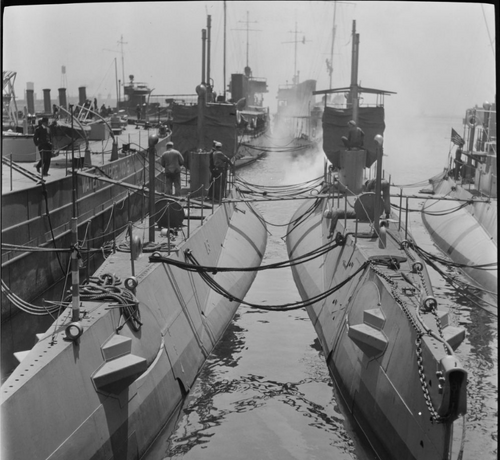
L-3 (Submarine No. 42) and L-4 (submarine No. 43) at the Boston Navy Yard, Charlestown, MA. in the fall of 1916. Both boats had arrived for a post-commissioning overhaul that lasted about five weeks. As built, the L-class did not have the 3"/23 caliber deck gun. They would be installed during a pre-deployment overhaul in Philadelphia in the summer of 1917. Also, at this point in their service these boats did not have the permanent metal chariot bridge structures, using instead a removable pipe-frame and canvas enclosure.
Photo courtesy of the Massachusetts Digital Commonwealth.
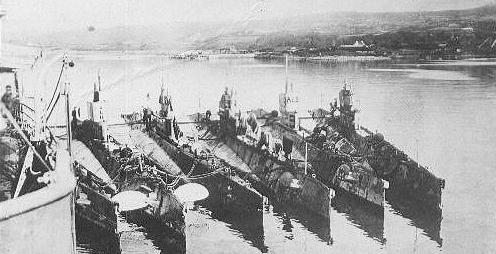
Photo in the private collection of Ric Hedman

Photo in the private collection of Ric Hedman
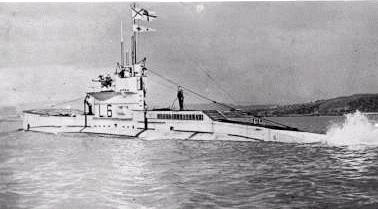
Photo in the private collection of Ric Hedman

Photo courtesy David Wright, Navsource, Destroyer Archives Manager, Yard & District Archives Manager.
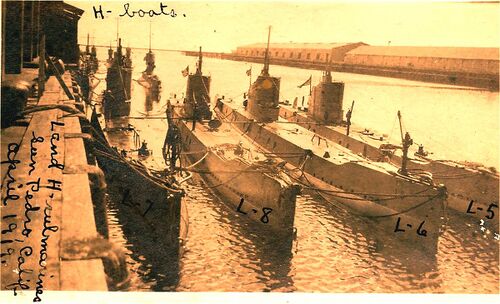
Photo contributed by Patricia Lynn.
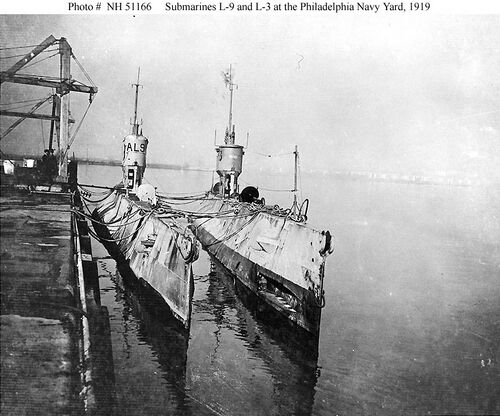
L-9 and L-3 moored in a nest at the Philadelphia Navy Yard, February 1919. These boats had just returned from the war zone and were looking pretty weary. They were in need of a thorough overhaul. Note that the shutter door is open for #1 torpedo tube on the L-3. It appears that the muzzle door for the tube is shut, as it would need to be to prevent accidental flooding. Most likely the mechanical linkage between the shutter door and the muzzle door has been disengaged for maintenance.
Photo NH 51166 courtesy of the NHHC.

Shortly after the photo above was taken, the nest was expanded by adding L-11 to the inboard side. This photo shows the three boat nest being warped out so that another L-boat in the background can be inserted into the inboard position. Philadelphia Navy Yard, February 1919.
Photo NH 51168 courtesy of the NHHC.

K-3 (SS-34) and an unidentified K-boat moored outboard of L-11, L-2, L-3, and L-9 at the Norfolk Navy Yard, Portsmouth, VA. approximately 1923. These boats were all decommissioned and would soon be moved to Philadelphia and later scrapped. Note that none of the chariot bridge fairwaters on the L-boats are exactly the same.
A few years after the end of WW I, the Navy decommissioned a large percentage of the coastal patrol submarines for two reasons. The first was to keep the United States in compliance with the post war treaty limits on tonnage of submarines. The second was that the Navy was rapidly shifting emphasis away from the coastal operations mindset for submarines and towards an open ocean, long range fleet submarine concept. WW I experience had shown how far behind technologically our submarines were when compared to the German U-boats. WW I had begun a paradigm shift in USN mindset.
Photo in the private collection of Ric Hedman
Page created by:
Ric Hedman & David Johnston
1999 - 2023 - PigBoats.COM©
Mountlake Terrace, WA, Norfolk, VA
webmaster at pigboats dot com
